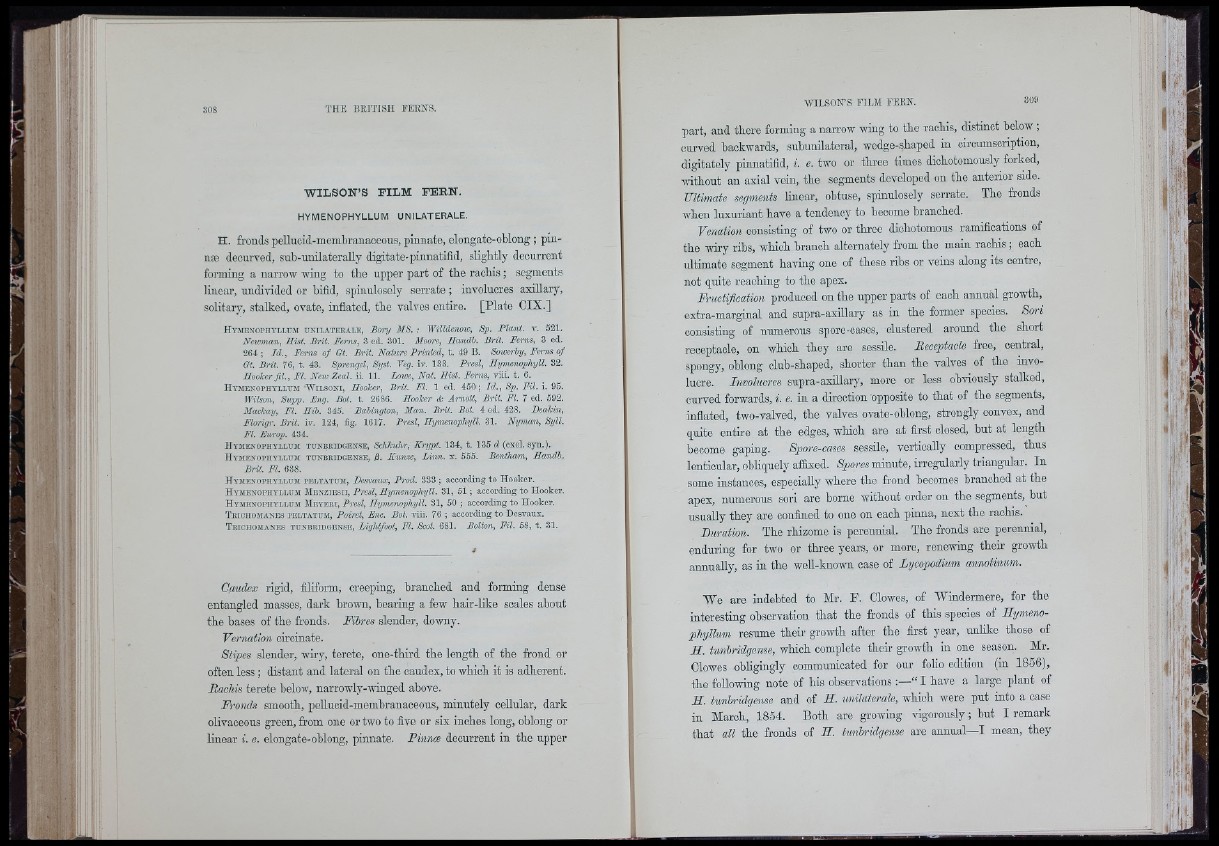
3 08 THE BEIT ISH EKENS.
WILSON’S FILM FERN.
HYMENOPHYLLUM UNILATERALE.
H. fronds pellucid-membranaoeous, pinnate, elongate-oblong ; piii-
nffi decurved, sub-unilaterally digitate-pinnatifid, slightly deourrent
formmg a narrow wing to the upper part of the raohis; segments
linear, undivided or bifid, spinulosely serrate ; involucres axillary,
solitaiy, stalked, ovate, inflated, the valves entire. [Plate CIX.]
H y m e n o p i iy l l u m u n il a t e e a l e , Bory MS. : Willdenow, Sp. P lant, v. 521.
Newman, Hist. B rit. Perns, 3 ed. 301. Moore, Handb. Brit. Perns, 3 ed.
264 ; Id ., Fcms o f Gt. Brit. Nature Printed, t. 49 B. Sowerby, Ferns of
Gt. Brit. 76, t. 43. Sprengel, Syst. Veg. iy. 133. Presl, Hynwnophyll. 32.
Hooker fil., Fl. New Zeal. ii. 11. Lowe, Nat. Hist. Ferns, viii. t. 6.
H y m e n o p h y l l u m 'W il s o n i , Hooker, Brit. Fl. 1 ed. 4 50; Id ., Sp. Fil. i. 95.
Wilson, Supp. Eng. Bot. t. 2686. Hooker A Arnott, Brit. Fl. 7 ed. 592.
Mackay, Fl. Hib. 345. Bahington, Man. Brit. Bot. 4 ed. 428. Deakin,
Florigr. Brit. iv. 124, fig. 1617. Presl, Hymenophyll. 31. Nyma n , Syll.
Fl. Europ. 434.
H y m e n o p h y l l u m t u n b e id o e n s e , Sehkuhr, Krypt. 1 3 4 , t . 1 3 5 d (e x c l. s y n .) .
H y-m e n o p h y l l u m t u n b r id g e n s e , 0. Kunze, L in n . x . 5 5 5 . Bentham, Handb.
Brit. Fl. 6 3 8 .
H ym e n o p h y 'L L UM p e l t a t u m , Deseaux, Prod. 3 3 3 ; according to Hooker.
H y m e n o p h y l l u m M e n z i e s i i , Presl, Hymenophyll. 31 , 5 1 ; according to Hooker.
H y m e n o p h y l l u m M e y e e i , Presl, Hymenophyll. 31 , 5 0 ; according to Hooker.
T e i c h o m a n e s p e l t a t u m , Poiret, Etc. Bot. viii. 76 ; according to Desvaux.
T e i c h o m a n e s t u n b e i d o e n s e , Lightfoot, Fl. Scot. 6 8 1 . Bolton, Pil. 5 8 , t. 31.
Caudex rigid, filiform, creeping, branched and formmg dense
entangled masses, dark brown, beating a few hair-Hke scales about
the bases of the fronds. Fibres slender, downy.
Vernation circinate.
Stipes slender, wiry, terete, one-third the length of the frond or
often less ; distant and lateral on the caudex, to which it is adherent.
Rachis terete helow, narrowly-winged above.
Fronds smooth, peUuoid-mombranaoeous, minutely cellular, dark
olivaceous green, from one or two to five or six inches long, oblong or
linear i. e. elongate-oblong, pinnate. Pinnæ decurrent in the upper
part, and there forming a narrow wing to the rachis, distinct helow ;
curved backwards, subunilatoral, wedge-shaped in circumscription,
digitately pinnatifid, i. e. two or threo times diohotomously forked,
without an axial vein, the segments developed on the anterior side.
Ultimate segments linear, obtuse, spinulosely serrate. The fronds
when luxuriant have a tendency to become hranohed.
Venation consisting of two or threo diohotomous ramifications of
the wiry ribs, which branch alternately from tho main rachis; each
ultimate segment having one of these ribs or veins along its centre,
not quite reaching to the apex.
Fructification produced on the upper parts of each annual growth,
extra-marginal and supra-axillary as in tho former species. Sori
consisting of numerous spore-cases, clustered around the short
receptacle, on which they are sessile. Receptacle free, central,
spongy, oblong club-shaped, shorter than the valves of the involucre.
Involucres supra-axillary, more or less obviously stalked,
curved forwards, i. e. in a direction opposite to that of the segments,
inflated, two-valved, the valves ovate-oblong, strongly convex, and
quite entire at the edges, which are at first closed, but at length
become gaping. Spore-cases sessile, vertically compressed, thus
lenticular, obliquely affixed. Siiores minute, irregularly triangular. In
some instances, especially where tho frond becomes branched at the
apex, numerous sori are borne without order on the segments, but
usuaUy they are ooufined to one on each pinna, next the rachis.
Buration. The rhizome is perennial. The fronds are perennial,
enduring for two or three years, or more, renewing their growth
annuaUy, as in the weU-known ease of lycopodium annotinum.
We are indebted to Mr. F. Clowes, of Windermere, for the
interesting observation that the fronds of this species of Hymeno-
phyllum resume their growth after the first year, unlUce those of
H. tunhridgense, which complete their growth in one season. Mr.
Clowes obligingly oommunioated for our folio edition (in 1856),
the following note of his observations “ I have a large plant of
H. tunbridgense and of 3 . unilaterale, which were put into a case
in March, 1854. Both are growing vigorously; hut I remark
that all the fronds of H. tunbridgense are annual—I mean, they
Y ;
"iiiv
¡tDl
I m m i Ml t i ' . ' f
l i ; /
liJ